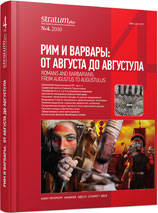Вооружение готов: свидетельства письменных источников в сопоставлении с данными археологии
Armament of the Goths: Written Records versus Archaeological Evidence
Author(s): Alexander K. NefedkinSubject(s): History, Archaeology, Military history, Ancient World
Published by: Издательский дом Stratum, Университет «Высшая антропологическая школа»
Keywords: Warfare; Armament; Armed Forces; Goths
Summary/Abstract: According to the ancient German tradition, the main body of the Gothic infantry consisted of shield-bearers armed with various spears for the long-range combat, and a sword and a dagger for close combat. A large shield provided an effective protection to the warrior, making any other protective armor unnecessary. With these large shields the Goths used to compose their traditional military formation known as “shield wall”, which was an efficient defense against enemy’s missiles. Written sources suggest that the Gothic (and especially Visigothic) archers were more skillful skirmishers than their Western relatives. Cavalry seems to have been better developed with Ostrogoths, as an effect of influence from nomadic Sarmatians and Alani. If in late 5th century, the Gothic horsemen were mainly mounted infantrymen, aſter conquest of Italy some of them actually became cataphracts. Riding horses protected in Byzantine manner and armed with lances like Sarmatians, driven by tribal “heroic” ethos, they preferred close combat. Visigoths preserved pure German military traditions, and cavalry became important to them much later, in Gallia and Hispania. Even though, it still preferred to fight mainly with missiles and defend by shields, while mounted lancers, probably armed in the Roman-Sarmatian manner, were less common.
Journal: Stratum plus. Археология и культурная антропология
- Issue Year: 2010
- Issue No: 4
- Page Range: 233-249
- Page Count: 17
- Language: Russian

